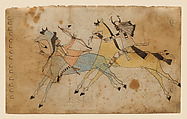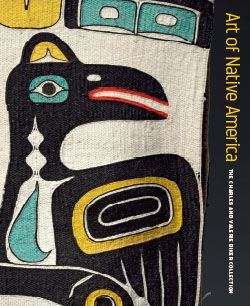Swift Dog Strikes an Enemy
Swift Dog Hunkpapa Lakota/ Teton Sioux
In the 1860s, Plains men began to render their personal histories and those of their people on sheets of paper and in ledger books that were captured from the military or obtained in trade. They executed these works in combinations of graphite, colored pencil, ink, crayon, and watercolor. Initially these depictions focused on moments of valor and victories in war, with occasional personal visions. Images of daily life—hunting, courtship, animals, dances, ceremonial events, and camp scenes—followed. These works extended the earlier tradition of autobiographical warrior art incised on rock faces and painted on robes, shirts, and tipis. They became a way to document tribal life and history, affirming fundamental cultural values.
Although the warrior-artist Swift Dog captures a dramatic moment of action in this ledger drawing, the delicate composition of flowing line and pale transparent color adds a detached elegance. Judicious use of the color black anchors both figures and their horses. The artist pictures himself in sacred face paint, wearing a split-horn bonnet with ermine skins and a beaded war shirt and leggings. He stretches forward, swinging his tomahawk; the enemy flings himself across his horse’s neck to avoid the blow. Swift Dog likely circulated this drawing among his comrades as he told the story of this fight with a Crow, or possibly Nez Perce, warrior.
Due to rights restrictions, this image cannot be enlarged, viewed at full screen, or downloaded.


